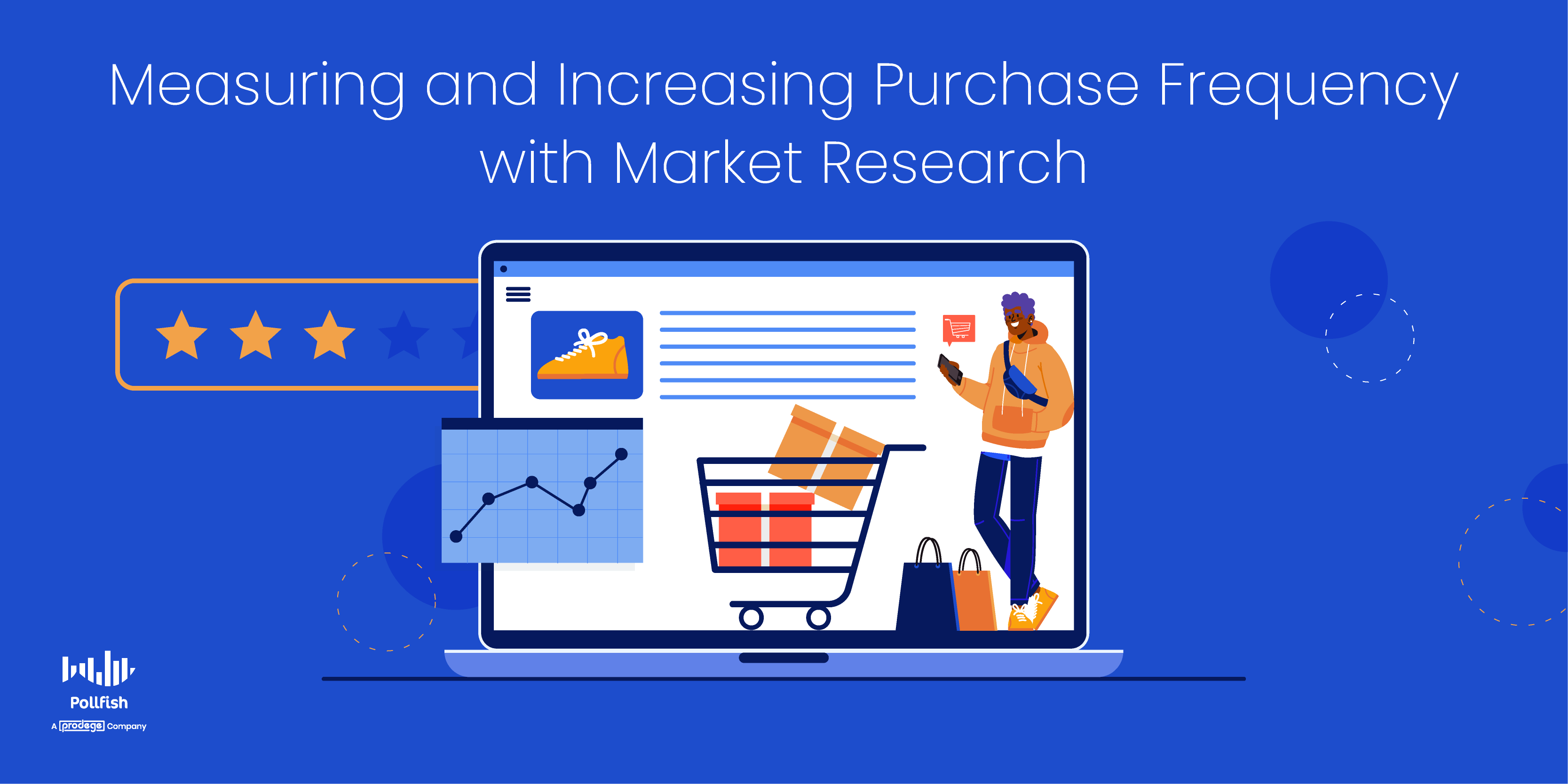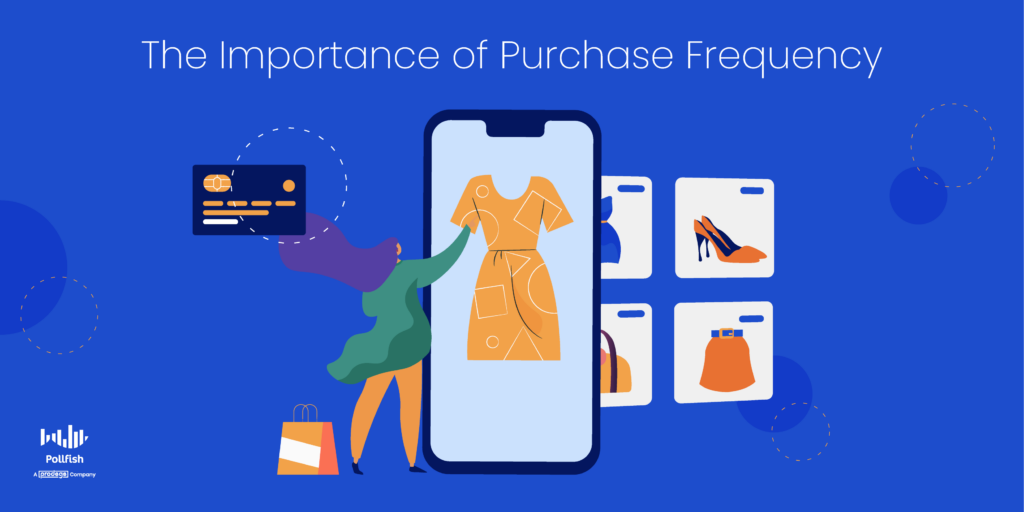Measuring and Increasing Purchase Frequency with Market Research

It’s essential to measure purchase frequency and its associated metrics, as these grant insights beyond their obvious measurement. That’s because evaluating this frequency allows businesses to evaluate and even track the intangible concept of consumer loyalty.
The importance of consumer loyalty cannot be stressed enough; it should be the ground rule of any business to build a base of loyal customers, as they buy from a company longer and provide a higher customer lifetime value.
In fact, 65% of a company’s business comes from existing customers. This represents the bulk of a company’s business, proving the value of customer retention. In addition, 43% of consumers spend more money on brands they’re loyal to.
As such, brands should be keen on keeping track of their purchase frequency and attempt to raise it to build customer loyalty and profitability.
This article expounds on purchase frequency, how to measure it and its key associated metric, and how to use market research to not simply measure it but increase it.
Understanding Purchase Frequency
Purchase frequency is a metric denoting the number of times an average customer buys a product or service from a single seller in a given period of time. It is one of the three key metrics that make up an RFM analysis, a technique used to estimate and analyze the value of customers based on the three data points of RFM.
RFM is an acronym for recency, frequency and monetary value. A kind of consumer analysis, it is used to segment customers based on these three factors that make up customer buying behavior. It allows market researchers to segment their customers to identify big spenders and infrequent buyers.
Purchase frequency helps businesses understand the success of their products and services, along with mapping out customer loyalty and its underpinning rate: customer retention rate. This is because loyal, aka retained customers, tend to buy more.
Not all sectors and their respective offerings have a fixed purchase frequency. Some consumer packaged goods, such as laundry detergent or mustard, have a relatively fixed purchase frequency. For example, some people buy lunch every day or soap weekly.
Products that are made to last for long periods of time, on the other hand, tend to have an intentionally lower frequency rate. This is self-explanatory, whether you are cash strapped or wealthy, it would be unwise to regularly buy something built to last years. (Take a refrigerator, for example).
In all, purchase frequency determines, on average, how many times a customer makes a purchase from a business and can be used for various purposes.
The Importance of Purchase Frequency
Purchase frequency is crucial to measure, keep track of and increase.
First off, purchase frequency ties directly into profits and the higher your frequency, the higher your profits will be. But the importance of this metric goes beyond its self-evident reasons.
The frequency of purchases is directly related to customer retention, since those who continue buying from you are the customers you can count as regulars, or repeat customers. Retention is important for maintaining continuous profit and consistent growth.
This is in part due to the fact that repeat customers spend 300% more than new customers. Aside from being more valuable, retaining your customers is also more cost-efficient, as it costs 5 times less to retain a customer than to acquire a new customer. As such, it is key to measure and sustain a high purchase frequency, as it is an indication of customer retention.

Piggybacking off of customer retention is the fact that a high purchase frequency is a marker of consumer loyalty. After all, why would any customer continue buying from the same brand if they were dissatisfied with its products, services or general CX? While they may continue buying the same product due to their needs, they would certainly switch brands if they experience a bad CX, or are generally dissatisfied.
Switching brands is a customer habit, which leads to another reason behind the importance of this metric. This is because determining this frequency is a part of market segmentation, the practice of segmenting consumers into distinct groups based on various shared characteristics. This is key, as it helps you organize and understand the makeup of your target market.
As such, you’ll be able to determine how often certain segments and customer personas make purchases from your brand and whether they use other brands to fulfill their needs. This enables you to form your marketing strategy around your segments’ habits.
In market research, understanding how often a consumer makes purchases within a given category gives a sense of their engagement with a brand. This will let you know where they stand in the sales funnel and how much nurturing they’ll need to purchase more.
Finally, purchase frequency data shows you critical insights into the timing of your purchases. This is because by examining it, you’ll understand the exact days and times of the day in which the most purchases occur.
This kind of data is especially necessary for logistics, inventory management and supply chain processes, as these aspects of business and their employees would need to know this information to ensure you never run out of items and can operate smoothly.
You can identify the customers that purchase the most and develop rewards programs in order to retain them.
How to Calculate Purchase Frequency
You can calculate the purchase frequency of your existing customers via two calculations, which represent different variations of purchase frequency. The first is the general purchase frequency formula; the second is the repeat purchase rate. Although they both reveal the regularity of customer buying, they represent two distinct concepts. The following explains their key distinctions.
Purchase Frequency Versus Repeat Purchase Rate
Purchase frequency
- Called a “laggy metric” because customers often make frequent purchases over a longer interval of time.
- This can be calculated from existing customers.
- This means that It is typically more accurate to measure purchase frequency over long periods of time, such as up to 12 months.
- Purchase Frequency Formula
- Customer purchase frequency = Number of orders ÷ Number of unique customers
- Remember to first calculate both of your variables. The former is the total number of processed purchase orders for your company.
Repeat Purchase Rate
- In contrast, to the above, the repeat purchase rate shows you the proportion of your customers that have purchased from you at least twice.
- This can be tracked more regularly, such as bi-weekly, weekly or even daily.
- An increase in the repeat purchase rate is always good news.
- It points to an improvement in customer retention, signifying that you’re providing your customers with great value.
- Repeat Purchase Rate Formula
- Repeat Purchase Rate = Number of customers who have purchased more than once in a year ÷ Total number of customers in a year
- There’s no definite rule to determine whether your repeat purchase rate is good or not; that depends on your industry and niche.
- Low-cost products tend to have a higher repeat purchase rate than high-value items intended to last.
- If you sell expensive goods, you should still aim to increase the repeat purchase rate for your sector.
How to Use Market Research to Measure and Increase Purchase Frequency
Calculating the purchase frequency and repeat purchase rate is far from enough when it comes to context. Although it is important to calculate the purchase frequency, it is not the end all be all when it comes to understanding this frequency and the habits and situations underpinning it.
This is because as metrics, these two calculations will show you the quantitative what, but not the qualitative why and how.
As such, you may learn how often certain customers shop from you, but not any of their reasons for doing so. This includes a swath of factors behind the frequency of their purchases, such as personal consumer preferences, purchasing power, financial environment, employment status, usage of the product, and various others.
Conducting market research is the answer to this lack of context. You can begin by first conducting secondary research on the typical members of your target market. This is useful, however, not all sources are accurate specifically to your consumers. In addition, some secondary sources may be outdated and don’t answer the specific questions you need for your business.
The most valuable form of market research is primary market research, as it allows you to extract all the information that’s most relevant to your business and market research study, yourself. When you’re mulling over syndicated research versus custom research, you ought to opt for custom research, specifically a market research platform, as it grants you complete control and ownership of your study.
An online survey platform specifically allows you to both measure and increase your purchase frequency. In regards to the former, all you have to do is ask the question of how often your customers make purchases. You can frame an entire survey on this, asking questions on the frequency that differ by specificity.
As for the latter, you can increase both your purchase frequency and repeat purchase rate with an online survey platform. This is because surveys provide a convenient and timely way to study your customers. They provide you with quick access to all of their needs, wants, aversions, expectations, preferences and opinions.
This allows you to innovate your products, structure your marketing campaigns better and improve your overall customer experience. When you optimize across all of these areas, you will improve your customer satisfaction, thereby developing brand trust and customer loyalty.
Increasing Purchases with Polling Software
Since surveys empower you with critical customer intelligence, you’ll be able to effectively measure and increase your purchase frequency. But you’ll need to be selective of the polling software you use for this campaign and all other market research campaigns.
Opt for an online survey platform that makes it easy to create, deploy and consumer surveys. Such a platform should offer random device engagement (RDE) sampling to reach customers in their natural digital environments instead of pre-recruiting them.
Your platform should have a mobile-first design since mobile dominates the digital space and nobody wants to take surveys in a poorly-built mobile environment.
Your online survey platform should also offer artificial intelligence and machine learning to remove low-quality data, disqualify low-quality data and offer a broad range of survey and question types.
The survey platform should offer advanced skip logic to route respondents to relevant follow-up questions based on their previous answers. It should also make it easy to form a customer journey survey to survey your respondents across their customer journeys.
Additionally, it should also allow you to survey anyone. You’ll need a platform with a reach to millions of consumers, along with one that offers the Distribution Link feature. This feature will allow you to send your survey to specific customers, instead of only deploying them across a vast network.
With an online survey platform featuring all of these capabilities, you’ll be able to adequately measure and increase your purchase frequency.
Pollfish Marketing Team
Ready to Try Pollfish?
Create your survey with AI, target high-quality respondents starting at $0.95 per complete, and start getting results in just minutes in real-time. From running a simple product concept survey to managing a constant stream of trackers for dozens of clients in dozens of countries, we’ve got you.

